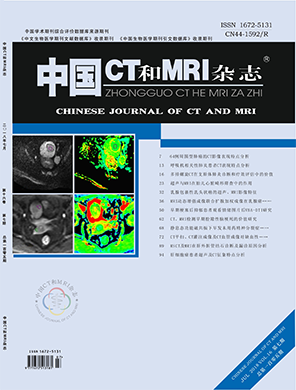论著-头颈部
超声与MRI在胎儿心脏畸形筛查中的作用
作者:殷保江1 贾晓辉2 杨星奎3
所属单位:1.舞钢市人民医院超声科(河南 舞钢 462500) 2.舞钢市人民医院CT室(河南 舞钢 462500) 3.舞钢市人民医院外科(河南 舞钢 462500)
PDF摘要
目的研究超声与MRI在胎儿心 脏畸形筛查中的作用,为寻找更合理有 效的检查方法提供理论依据。方法 选 取2014年12月-2017年12月我院产前检 查孕妇7438例,根据孕周分为孕中期 (孕20-28周,n=5132)和孕晚期(孕28-36 周,n=2306)两组,分别采用超声快速扫 描、超声心动图和MRI进行检查,比较 和分析三种检查方法对两组胎儿检查结 果。结果 7438例胎儿中引产或出生后证 实存在心脏畸形者64例(0.86%),B超常 规扫描、2D FIESTA和超声心动图分别检 出54例(84.38%)、57例(89.06%)和58例 (90.63%),三种检查方法孕中期检出率分 别为88.37%、86.05%和93.02%,孕晚期检 出率分别为76.19%,90.48%和85.71%。结 论 B超与MRI用于胎儿心脏畸形产前筛查 各有优势和不足,正常情况下,胎儿心脏 超声快速扫描可基本完成筛查工作,漏 诊率较低,对可疑病例可补充超声心动 图确诊;MRI发展较晚,但进步迅速,2D FIESTA序列用于胎儿心脏畸形产前诊断可 在多方面弥补超声检查的不足,故而可作 为一种有效的补充手段。
Objective To study the role of ultrasound and MRI in the screening of fetal heart malformation and provide theoretical basis for finding more reasonable and effective inspection methods. Methods 7438 cases of pregnant women in prenatal examination in our hospital from December 2014 to December 2017 were selected and divided into two groups of second trimester (20~28 weeks, n=5132) and third trimester (28~36 weeks, n=2306) according to gestational age, and the two groups were examined by ultrasonic rapid scanning, echocardiogram and MRI respectively. The results of three inspection methods for fetuses were compared and analyzed. Results There were 64 cases (0.86%) with heart malformation in induced labor or after birthamong 7438 cases of fetuses, and 54 cases (84.38%), 57 cases (89.06%) and 58 cases (90.63%) were detected by routine B ultrasound scan, 2D FIESTA and echocardiogram respectively. The detection rates of three inspection methods were 88.37%, 86.05% and 93.02% respectively in the second trimester, and were 76.19%, 90.48% and 85.71% respectively in the third trimester. Conclusion B ultrasound and MRI have advantages and disadvantages in prenatal screening for fetal heart malformation. Under normal circumstances, fetal ultrasonic rapid scanning can basically complete the screening with low rate of missed diagnosis, and supplement echocardiogram for diagnosis of suspicious cases. MRI is of late development but rapid progress, and 2D FIESTA sequence can make up for the lack of ultrasound in many ways from the perspective of prenatal diagnosis of fetal heart malformation, therfore it can be used as an effective supplementary means.
【关键词】超声检查;磁共振成像;心脏畸形;胎儿;筛查
【中图分类号】R322.1+1
【文献标识码】A
【DOI】10.3969/j.issn.1672-5131.2018.07.008
前言
胎儿心脏畸形是一种常见的发育缺陷,我国每年约有数万新生 儿患有不同类型心脏畸形,发病率约0.7%~0.8%,存活率不到8%, 可死于宫内或出生后[1],可严重威胁患儿生命安全,给家庭和社会造 成巨大负担,影响国家优生优育政策实施[2]。产前进行安全合理的影 像检查,并以此为据进行早期诊断和干预,减少畸形患儿出生,是提 升人口质量的有效手段,其中产前超声(ultrasound,US)是临床首选 检查方法,但易受羊水、胎儿体位以及身体其它部位干扰,胸腔内组 织显示效果不尽人意,造成诊断准确性降低[3],近年来,磁共振成像 (Magnetic Resonance Imaging,MRI)技术飞速发展,已可广泛用于 胎儿各系统发育情况检查[4],故胎儿畸形筛查可采用B超与MRI联合进 行,本文对超声与MRI在胎儿心脏畸形筛查中的作用进行比较分析和归 纳总结,旨在为提高胎儿心脏畸形检测准确率提供理论依据。
中国CT和MRI杂志
第16卷, 第 7 期
2018年07月

相关文章